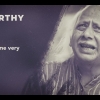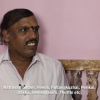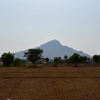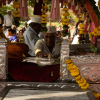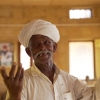Guru Bichitrananda Swain is one of the leading gurus and choreographers of Odissi today. Swain was passionate about dance from a very early age, and after much hardships he got admitted into Utkal Sangeet Mahavidyalay. He considers Guru Gangadhar Pradhan as his first guru and, later on, he was mentored by Sanjukta Panigrahi and Kelucharan Mohapatra. He is accredited with introducing the purushang, the male form in choreographies, and is said to have tweaked the sensual, feminine movements of Odissi to suit the masculine form. He has created productions specially for male dancers and has trained several of leading Odissi dancers. He and his disciples have performed across India and abroad under the banner of Rudrakshya, the institution he founded in 2003.
Following is the edited transcript of the conversation with Bichitrananda Swain conducted by Madhur Gupta in Bhubaneswar, 2018.
Madhur Gupta(MG): Tell us about how you began your journey in Odissi.
Bichitrananda Swain(BS): I was interested in dance from a very early age. It was only after a lot of struggle and hardship that I was able to join Utkal Sangeet Mahavidyalay to learn dance. When I joined it, initially, my father did not know. But when he came to know about it, he was very happy and even helped me. He regularly gave me money to pay my hostel fees. My father passed away when I was in the fourth year. From that day, another phase of my sorrow began. There was no one to help me. I did not like to take private tuitions and all to make money. I managed to eat sometimes, but most of the time I went without food. Sometimes I ate only once a day. Sometimes I didn’t get even that. My life was like that of a boy living on the street. There was so much sorrow in my life. There were no good clothes for me, let alone the costume for dance. There was a boy in the junior classes—Manoranjan Pradhan—he shared his food that came from his home. That was how I survived.
MG: Who were your teachers at Sangeet Mahavidyalaya?
BS: Guru Pankaj Charan Das, Guru Deb Prasad and Bichitra Dutt Chaudhary were my teachers. But I did not learn anything from them. I am fortunate because I got Padmashri Guru Gangadhar Pradhan as my first guru. He was a very good guide. Later my guru was Padmashri Sanjukta Panigrahi. Then I joined Odissi Research Centre. There my mentors were Kumkum Mohanty and Kelucharan Mohapatra. I am very fortunate that I was blessed with the presence of all these great gurus in my life. On one side I was like an orphan, neglected and poor, but on the other side, I had all these great gurus in my life.
MG: How did you meet Guru Gangadhar Pradhan?
BS: Veeravara Sahu was a Gotipua [a dance tradition going back to the sixteenth century in which young boys dressed up as girls to perform] guru. Guru Gangadhar too was a Gotipua performer. Veeravara Sahu introduced me to Guru Gangadhar, and I joined his dance academy. Initially I had stayed at an ashram, and later I stayed at the academy. I became a teacher there, and then later I became its principal.
MG: Tell us about your experiences with Guru Gangadhar.
BS: He was a great teacher and a nice human being—very loving, very caring. He was very disciplined. We were more like brothers than guru and disciple.
MG: How is Guru Gangadhar’s style different from that of Kelu Babu?
BS: There is no difference. He himself was Kelu Babu’s student. He was a good mardal [a percussion instrument] player. He had accompanied Sanjukta on many of her performances in India and abroad.
MG: You have been in this field for a long time. Could you tell us about the changes that may have happened in the technique and style?
BS: Actually, we all are under the impression that Odissi is growing and developing. No, it is not. The style we learned from our gurus—Sanjukta and Kelu Babu—their way of teaching, their technique was very natural and realistic. Now there is so much adulteration. Even in the case of Odissi costume. The Odissi performers in Delhi are staying true to the tradition, but Kolkata, Bhubaneswar—they are spoiling the true Odissi style.
MG: Why do you say that?
BS: Because they experiment too much. What will happen if you experiment too much? You should do that only in moderation, within the boundaries of the art form. You start doing things that are beyond the scope of the dance, then you are spoiling the style.
MG: You have also experimented in your choreographies. You established the Rudrakshya Foundation in 2000. You are known for introducing the purushang (male form) in Odissi choreographies.
BS: You are talking about purushang—I too was handsome when I was young. Then there was no chance for boys to dance on stage. I too wanted to perform on stage. I too tried so hard to be a dancer. When it didn’t happen, I was so full of sorrow. I knew dance is a glamorous thing. Whether it is a girl or a boy, the dancer has to be beautiful. But it is not like in the movies. Movies are different. There you need only to be true to your character. But in dance you need a beautiful physique. I decided that all the boys that came to learn from me, I would not allow their lives to go to waste. I told them to become dancers and not just gurus.
MG: So, earlier, boys who learnt Odissi would become teachers and not performers. How did you bring about that change?
BS: I encourage all the boys who joined Odissa Dance Academy to perform, and gave them opportunities to dance on stage. Everyone appreciated their dance. I had to work on certain aspects. For example, the costume, make-up… everything was made to suit the female gender till then. There was a seminar at Sangeeta Natak Akademi, Delhi, where Jayant Kastuar did a workshop on male dancers. I had done a choreography specifically for male dancers previously. He saw that and told me: This is all fine, but you need to rethink the costume and make-up. A boy dancing to Sankarabharanam pallavi will not look nice. I thought about it a lot and experimented. I created items specifically for male dancers. A full repertoire from mangalacharan till moksha [items of traditional Odissi repertoire], I created for male dancers. Dance does not belong to any gender. We have to understand that first. Sometimes, our boys too have to play female roles. For example, if he is playing Saki He from Geeta Govinda, he has to transform into a female role. That is acting. If you are dancing the role of Radha, you have to become Radha. Likewise, if you are dancing the roles of masculine characters, you have to do that. Technique is the same, regardless of the character.
MG: What about the typical feminine movements? Have you made any change for the male dancers? Your choreographies like Taal Madhurya, Taal Tarang, etc., are very male-oriented. How did you come up with them?
BS: Most of the dancing sculptures that you find in temples are that of females. Sculptures of male dancers are very rare. If there is any, then they are playing maddala or some other instrument. So, you rarely find poses for male dancers in temple sculpture. But you can see the body language of Krishna in pattachitra [scroll parinting tradition of Odisha]. In the choreographies expressly created for boys, I made changes in certain poses, and moves. For example, I left out chibukamandana [a typical Odissi pose] because a boy doing chibukamadana doesn’t look good. I adapted only those mudras and poses that will look good for boys.
MG: Your dance supports masculine grace more.
BS: Yes, but it supports feminine, too. But I have taken special care to establish the masculine style.
MG: You have many iconic choreographies like Karna, Taal Madhurya, etc. From where do you get the inspiration for them?
BS: See, I won’t call it inspiration, but I have a sense for choreography. When I was a student, I attended a seminar just to listen to Sanjukta. She said: An artiste who doesn’t have creativity within her/him, she/he cannot be called an artiste. I was shocked. I was just a student then. I thought I didn’t have any creativity within me, so I would never be able to become an artiste. I was very sad. Then I thought of Guruji and how he created all those pallavis. From then on, my mind was in a turmoil. How does Guruji create all those dance compositions like pallavi, abhinaya, etc.? How does he think up all those sculptural poses? I thought I didn’t have that sort of creativity in me. His case was an extreme one. It was a natural gift. If one day you suddenly decide to choreograph and begin to do it, nothing would come to you. It is like writing poetry. It may not come to you if you deliberately sit and attempt to write. It will only come at a particular time and place. You can’t bring it out by force.
MG: How much do you think the choreographic styles of your gurus like Gangadhar Pradhan influenced your choreography?
BS: When we are learning under him, we would only try to emulate him. He was showing us the way. We have to go down the route he was showing us. So, when I started choreographing, I thought, if I took ideas from pallavis like Saveri, Sankarabharanam, Bilahari, etc., people would watch and see only Sankarabharanam Pallavi and not my composition. Where was ‘I’ in it, where was my stamp in the piece? I wanted the audience to watch my choreographies and say that these are Bichi’s own creations. I worked on my choreographies and tried to create choreographies that are different, and not like what my gurus choreographed. I would take pointers from them, but use them cleverly so that no one would be able to tell. How can I forget the way that they had showed me!
MG: Coming back to an earlier point, Gotipua is now getting more and more stylised while the Odissi dancers are bringing in folkish elements in their dance. Could you comment on this?
BS: See, this is one’s own choice. The dancers in Delhi, whether they are good or bad, are keeping true to the tradition. Here, in Odisha and Kolkata, the traditional way is slowly dying out. They are more into experimentation, which, as I said earlier, doesn’t bode well for the dance. They perform anything in the name of Odissi. Only their costume is that of Odissi. I don’t like it.
MG: You must have taught at least two to three generations of dancers. What do you feel about the commitment level of the current dancers? Is the new generation of dancers as committed as the old generation? Will they take the dance form forward?
BS: Sure. I have seen my students, and how serious they are about the dance. They are knowledgeable and talented, and I am sure they will keep the tradition alive and take it forward.








